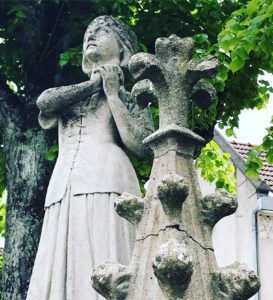Bastille Day, July 14, is a time to reflect on the enduring friendship between France and our country and on the revolutions that gave them birth — often with a Champagne flute in hand. Some Georgetowners are lucky enough to celebrate France’s national day in Paris. But wherever one goes in La Belle France, one somewhat strangely departs with a greater appreciation for being American.
I experienced this irony firsthand as I explored the World War I battlefields and monuments in the French Aisne and Meuse departments (subregions), 100 years after Americans perished there by the thousands for Europe’s liberty.
While the graveyards and memorials are sobering reminders of the harsh realities of war, the area is brimming with charm and majestic chateaux to round out your travel diary. Your friends who frequent Paris and Cannes will be impressed that you ventured from the usual path to the Hauts-de-France region, which has just as much — perhaps even more — glamour and history.
A fabulous example is the Château de Fère-en-Tardenois, the construction of which began in 1206. Today, it is a cinq-etoiles (five-star) hotel offering luxurious spa and dining possibilities amid sweeping vistas of the Champagne wine region. The hotel, operated by public and private entities, is a unique mélange of modern elegance and ancient heritage.
Not far away is the Aisne-Marne American Cemetery, where more than 2,200 World War I soldiers were laid to rest under the northern French sunshine. This month marks 100 years since Americans seized the hill on the Marne Valley. On Memorial Day, a new visitor center opened to teach the next generations about the sacrifices and bloodshed of the Aisne-Marne Campaign.
Military buffs won’t want to miss Belleau Wood nearby, where the U.S. Marines delivered a great victory in June of 1918, earning the forest the title “Wood of the Marine Brigade.” Many of the trees around the small Marine monument are still standing a century on. You may recall that President Emmanuel Macron gave a sapling from Belleau Wood to President Donald Trump on his recent state visit.
In the Meuse subregion, within the historical Lorraine region (now Grand Est), I walked the German trenches of Apremont-la-Forêt, a lush spot of woods — so peaceful, you’d never know that barbed wire, bullets and remnants of soldiers’ boots lay just beneath you. Skeletal remains of the fallen are still being found. At Verdun, another sinister look at the Great War: a museum and battlefield commemorating the 300,000 lives lost in 300 days in the French village, which was awarded France’s Legion of Honor for the courage of its citizenry.
While in Verdun, check out the newly opened Les Jardins du Mess — a modern hotel, right on the Meuse River — which was a military building in the 19th century. Brigitte Bardot makes an appearance (okay, only in the artwork in the lobby).
Before heading to my final Great War landmark, I spent an evening ensconced in old French country decadence at the Château des Monthairons, built in the late 1850s. The castle is presently run by a charming French family. They love American visitors. Rooms overlook a vast green park where a large heron colony nests in the trees every spring. My room was so much like a blue version of Marie Antoinette’s salon, I didn’t want to leave it, other than for an al fresco breakfast on the portico or a candlelit supper in the dining room.
The highlight of my trip was a rainy afternoon at Meuse-Argonne, the largest American cemetery in Europe, where 14,000 patriots are buried. The Meuse-Argonne Offensive was the most expansive in American history, involving more than a million soldiers. The offensive’s success, while a massive sacrifice, led to Armistice on Nov. 11, 1918.
I was especially moved to see the handful of women laid to rest there. They were nurses, many of whom died of the flu just weeks before the war ended. Several rows back is the grave of Freddie Stowers, an African American who served in a segregated regiment. He was awarded a posthumous Medal of Honor in 1991, more than 70 years after his death.
A visit to this part of France is a bittersweet voyage worth taking anytime, but especially during the Great War’s centennial year.







